After the tight schedules in December, there was another huge clash, a derby between Manchester United and Manchester City in the English League Cup. With almost no title hope in the domestic league, this tournament became a good opportunity for both teams to win a trophy.
In the previous round, they beat Colchester United by three goals. However, United did not have their best form recently. They just newly lost to Arsenal, drew a game against Wolves.
For City, Pep Guardiola made some adjustments on his teams since some unsatisfactory performances. They slightly rotated the team in the FA Cup for the derby, of course, looked for retaliation for the defeat in the league.
In this tactical analysis, we will show you the tactics of United and City. The main focuses of this analysis are the inefficacy of United on both ends and the high-quality pressing of City.
Lineups
Ole Gunnar Solskjær lined his team in a 4-2-3-1 formation. His choices of players were limited due to several injuries, the latest player injured was Harry Maguire. Both pivots, Paul Pogba and Scott Mctominay were sidelined. Therefore, Fred and Andreas Pereira played as the defensive midfielders. Mason Greenwood took the central forward position while Marcus Rashford started as the left-winger.
Pep Guardiola’s team did not use their tradition formation or a back three. Instead, they tried a 4-4-2 system with Gabriel Jesus and Sergio Agüero on the bench. Bernardo Silva and Kevin De Bruyne were the front players on paper. Although Aymeric Laporte was backed to training sessions, he was not fully fit for an intense derby. Fernandinho and Nicolás Otamendi partnered as the centre-backs.
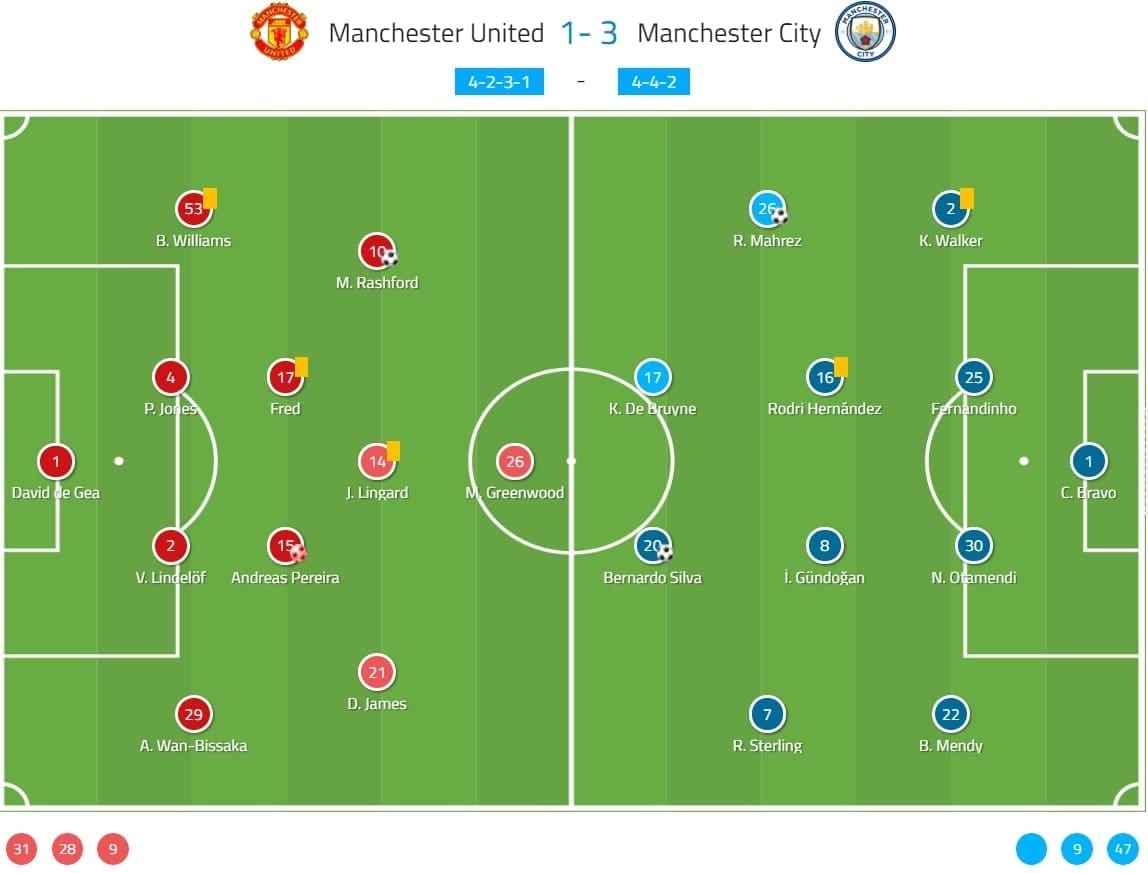
Defensive issues of United
United did not replicate the game plan of the previous derby, instead of sitting deep, they pressed high to disrupt the City’s build-up. Their press was man-oriented. In the early stages of the game, Jesse Lingard was marking Rodrigo Hernández, whose position was regarded as the main source of City’s attack. Greenwood pressed Bravo as the Chilean made a few errors under pressure previously, for example, the Everton game. They allowed Rashford pressed Fernandinho as Brandon Williams would also step up to mark the wide player.
However, as De Bruyne has said, City had dealt with a similar system before. United did not perform their best under this system, their players did not mark their targets tightly. It gave the players plenty of room to receive the ball freely, as De Bruyne did below.
Another issue was the number in the midfield. When De Bruyne dropped deep and Fred followed, Pereira became the lone pivot centrally. There was another City player dropped to the midfield, Silva, hence, he overloaded the Brazilian with Ilkay Gündoğan, received the ball from the Belgian and continued the attack.
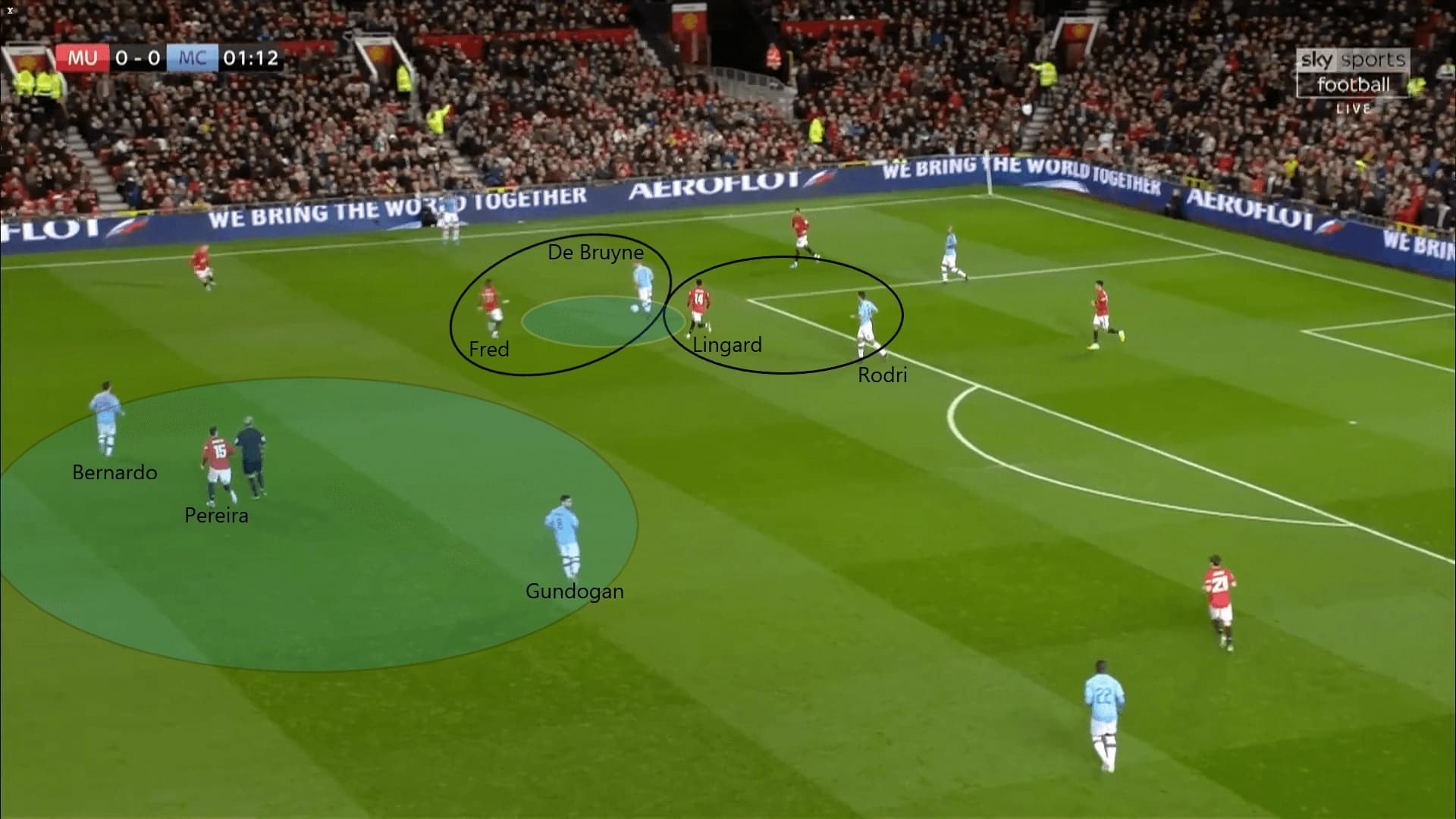
City created and exploited spaces
City played very well to break the high press by exploiting spaces. One of the key features of their style in this game was the dropping of front players. Below is the heat map of Silva, who started as a central forward on paper, but as shown, he was everywhere of the pitch.
With the extra man approach, United were difficult to deal with the attack of City when they hold a high line. If the centre-backs stepped out to follow Silva, then they were exposed, as other City players were always readied to attack the spaces behind the defenders. This was how Riyad Mahrez scored the second.
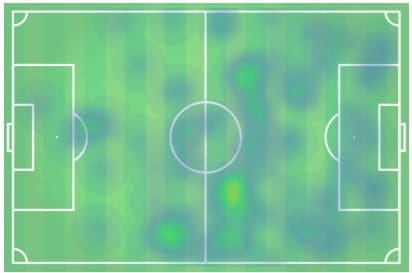
Despite facing pressure from United, they managed to play out from the back by creating spaces, then exploiting them. The presence of dropping players was important as this added an extra number at the midfield. In this example, which Bravo received a return pass, Greenwood was pressing him while Lingard was marking Rodri. The Spaniard was clever, he did not request for a pass, instead, keeping himself aside, leaving a passing channel opened to Silva. When the Portuguese dropped that deep, United pivots did not follow. They did not want other City players exploited the spaces between the lines.
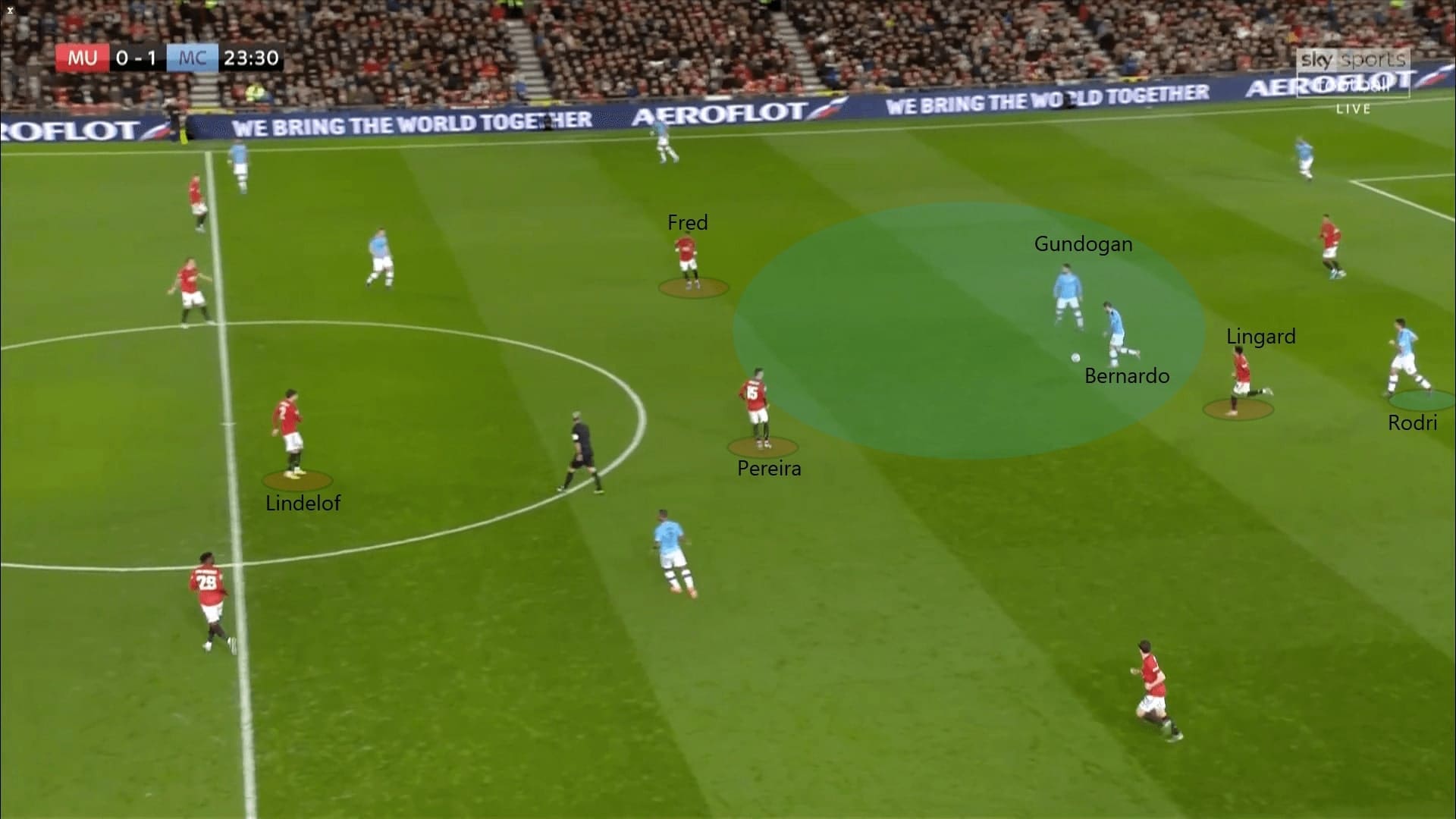
Another strength of City was their ability to play in a tight area. Despite United tried to lock down the ball side, their loose marking allowed City to have room to escape. City were good at creating spaces by moving the opposition.
We use this below scene to illustrate. In this scene, Kyle Walker got the ball but Rashford showed no incentive to press him. Meanwhile, Lingard was aware of Rodri, slightly positioned himself towards the Spaniard. Despite Daniel James inverted to mark De Bruyne, Pereira, still paid attention to the Belgian. As a result, Gündoğan got some rooms to receive the ball.
In order to further increase the space around the German, Silva made a forward run which distracted Fred. Walker found Gündoğan easily. This was how City players created spaces for each other in tight areas; unselfish runs.
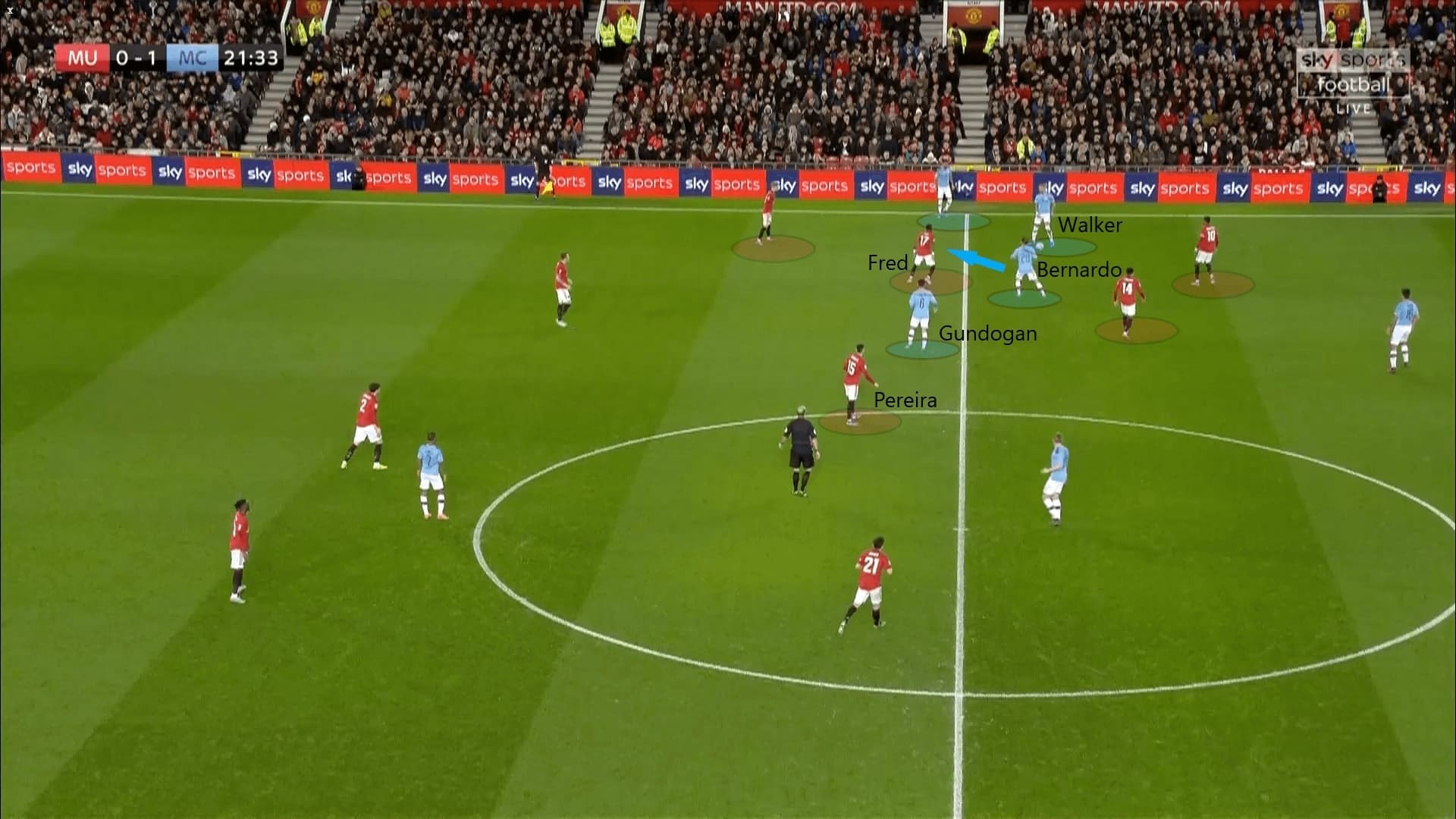
In the 17th minute, Silva scored a screamer, and, United’s high press could not prevent City from moving the ball. Then, they backed off more often, forming a 4-5-1 midblock to deny the penetration of City. The below scene was a rare occasion, as Solskjær allowed Rashford to position himself higher and join transitions promptly.
On the other hand, this scene also demonstrated another element of City’s attack. They used wide players to stretch the United defence. On the right, Walker stayed provided the width. On the left, it was Raheem Sterling in the first 15 minutes, then shifted to Benjamin Mendy as the English international came inside to attack the goal more often.
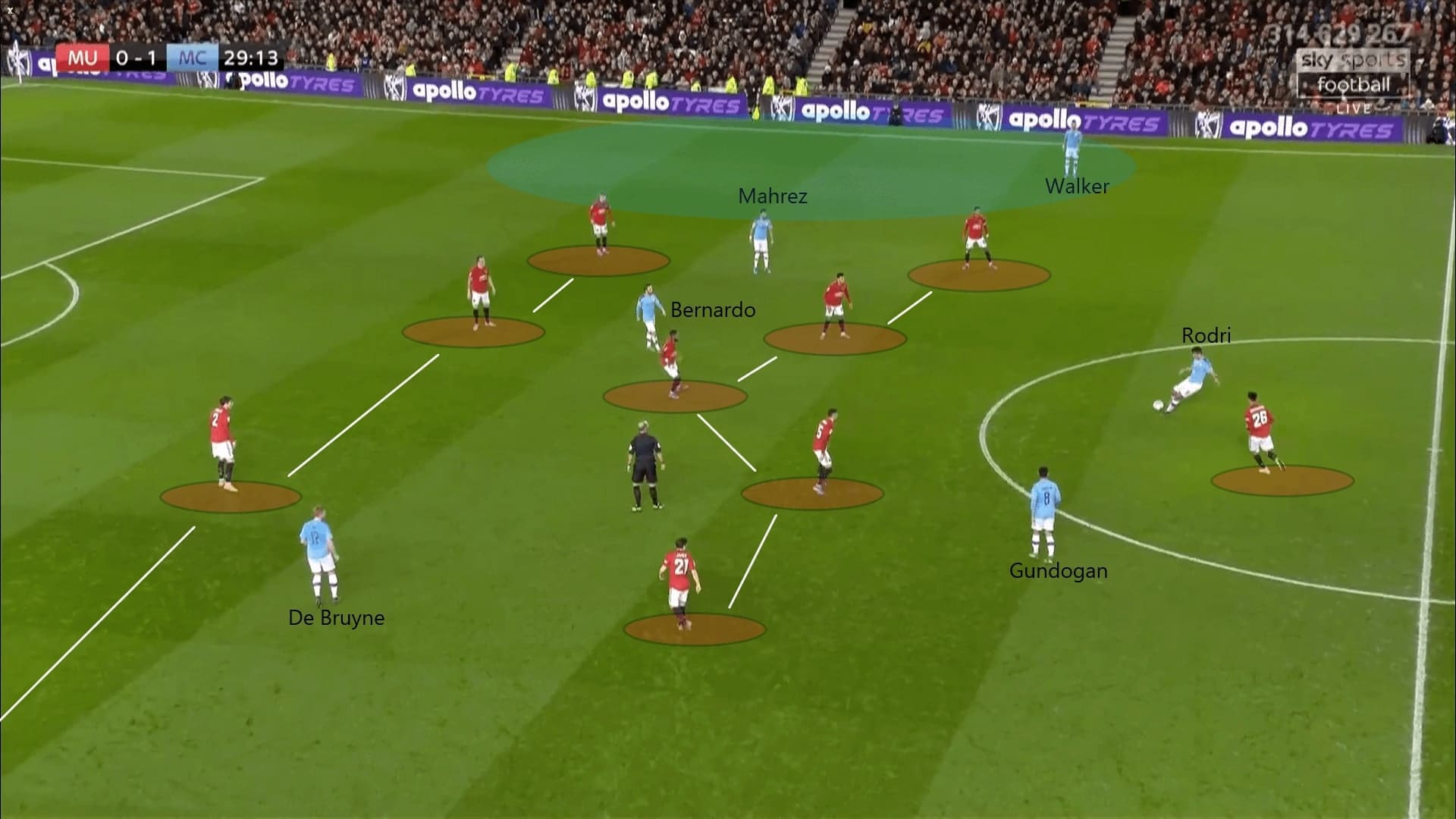
City: Art of high press
Apart from the attack, the high press of City also helped them to control the game. Below is the long-ranged passing map of David De Gea. Among his nine long passes, only two of them found his teammates. Nearly all long passes attempted to the opposition half failed, except the one to Lingard.
However, this was not because of the poor technique of De Gea, in many cases, he was forced to pass long.
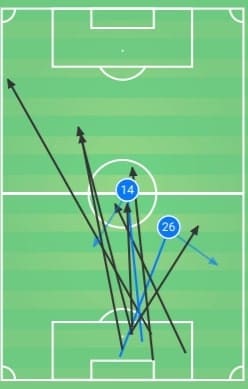
In this match, City pressed in a 4-4-2, with De Bruyne leading the line. The Belgian would instruct his teammates to follow him, so City could press in a unit. The biggest objective of their press was to force United to play long predictably. When that happened, blue shirts defenders would step up to fight for the ball.
City did this by denying the build-up of United, they wished United players to return the ball to De Gea. Then, the Spaniard would discover all his short options were eliminated, then, his only option was playing long. De Gea received 28 passes in the game, and 19 of them occurred in the first half, this showed how successful was the press of City in the first half.
The following image showed how City pressed. They controlled opposition players. De Bruyne and Silva were on both centre-backs; Sterling on Aaron Wan-Bissaka; Pivots on pivots; Mahrez on Williams.
However, City’s brilliance was not the man-marking approach, instead, it was their pressing trap. Although Rodri was marking Fred, he allowed the Brazilian to receive the ball, then closed him off, forced Fred to decide quickly.
There was also a problem from United’s perspective. Fred received the ball in closed body shape. This hindered the Brazilian to scan the pitch in a wider angle, or, make a lateral pass or a forward pass. The only option of Fred was to return the ball to De Gea if he did not take the risks to pass to Pereira.
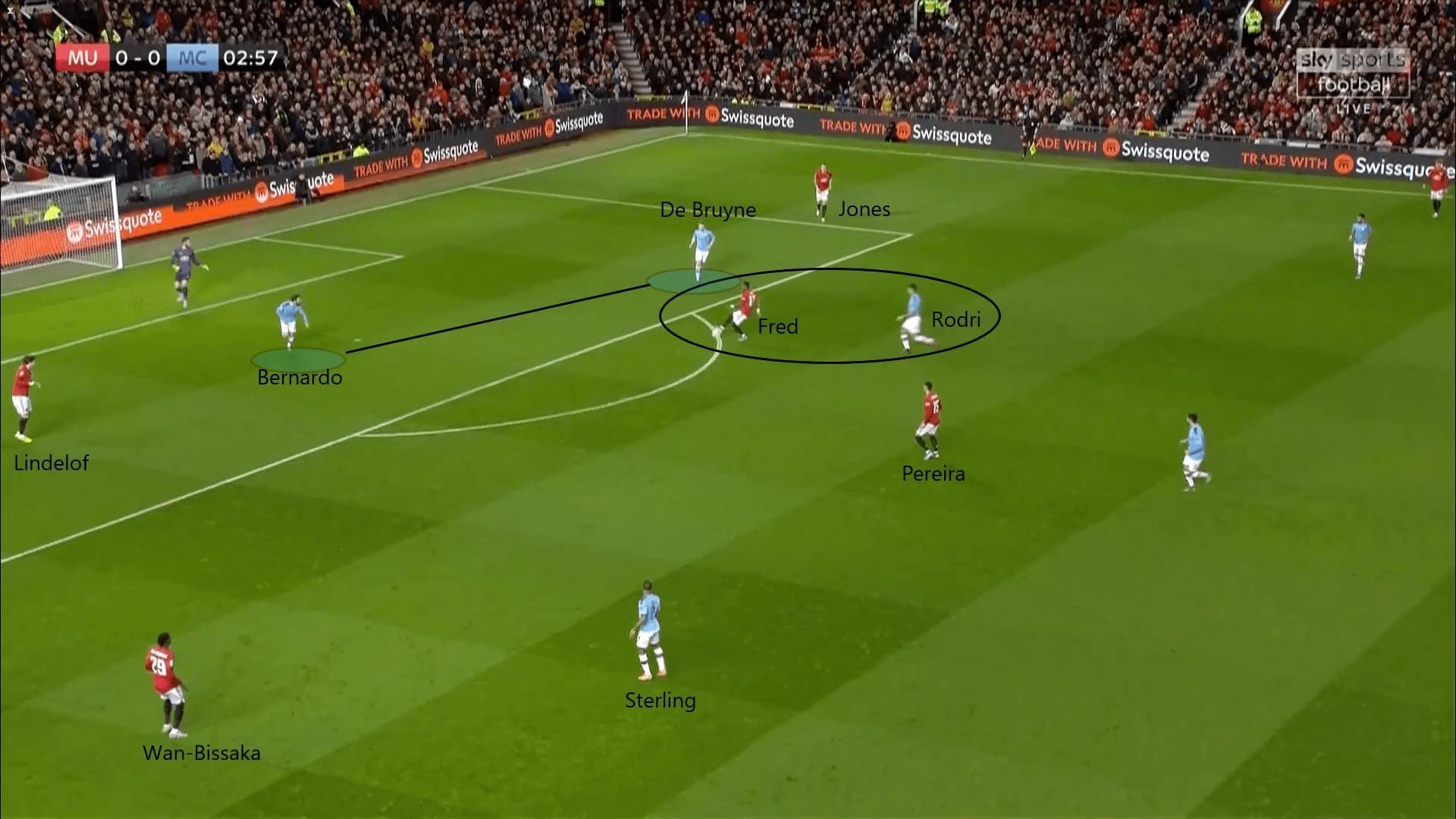
This example showed the importance of De Bruyne and Silva in their press. These two players were clever to execute the plan. Once Victor Lindelöf received the ball, De Bruyne cleverly reduced the distance with Silva, instead of chasing the ball. This disallowed the Swedish to switch play with his weak foot, while Silva’s press covered Fred also.
Again, from a United point of view, the same problem occurred here, Lindelöf received the ball with closed body orientation. Hence, he could not pass forward. The only option was to return the ball to De Gea. If the Swedish made any additional touches, he had to deal with Silva, which was a risk he did not want to take.
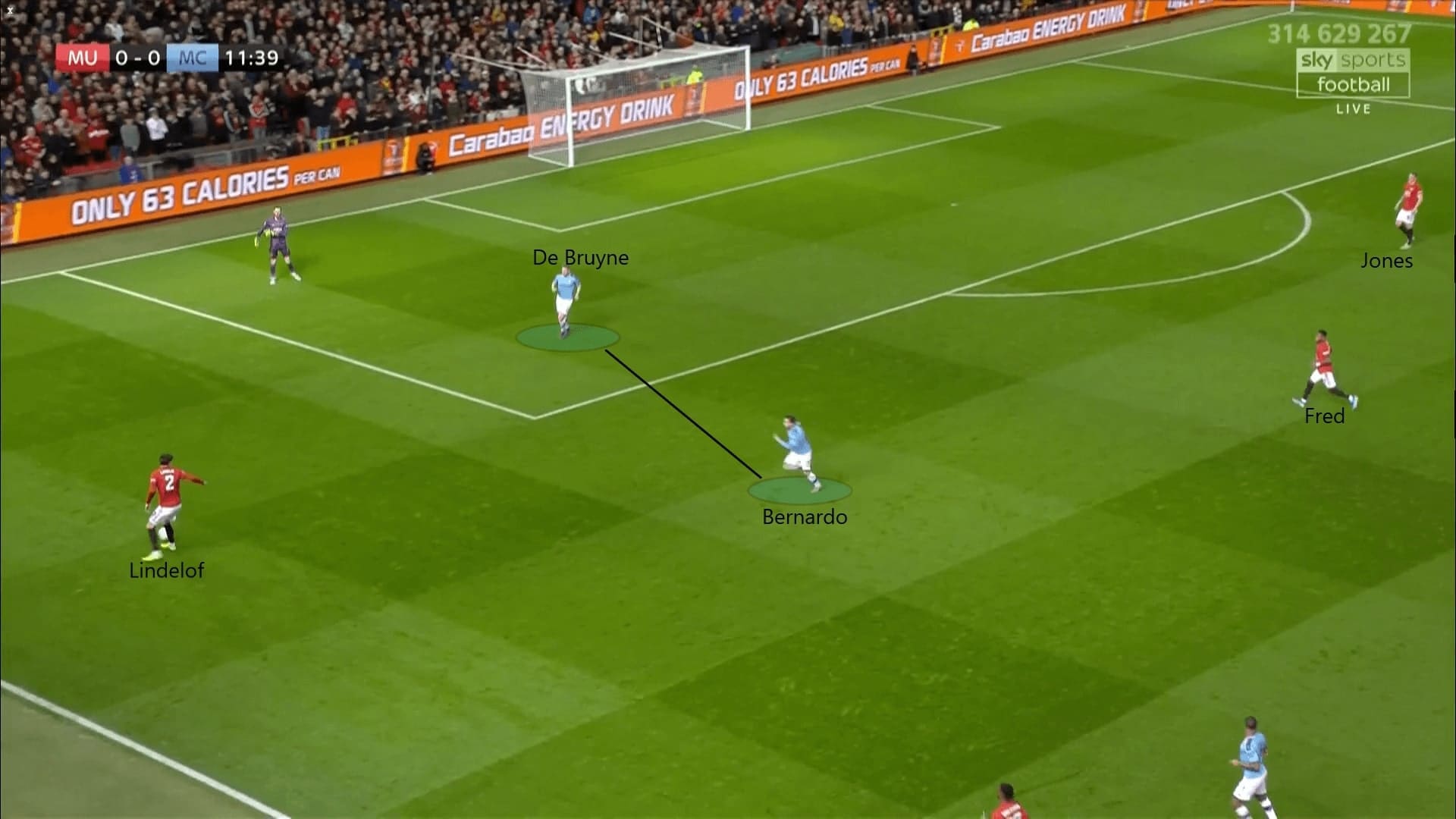
Here was another example to demonstrate the pressing trap of City. De Bruyne and Silva did their job, instead of pressing Williams or closing off Fred, they moved forward to deny the pass to Phil Jones or De Gea. As a result, it seemed Fred was the only free option.
Meanwhile, Rodri anticipated the pass, accelerated and closed off the Brazilian, forced him to pass in an instant. Clearly the Brazilian did not think quick enough, he panic, played the ball to Fernandinho.
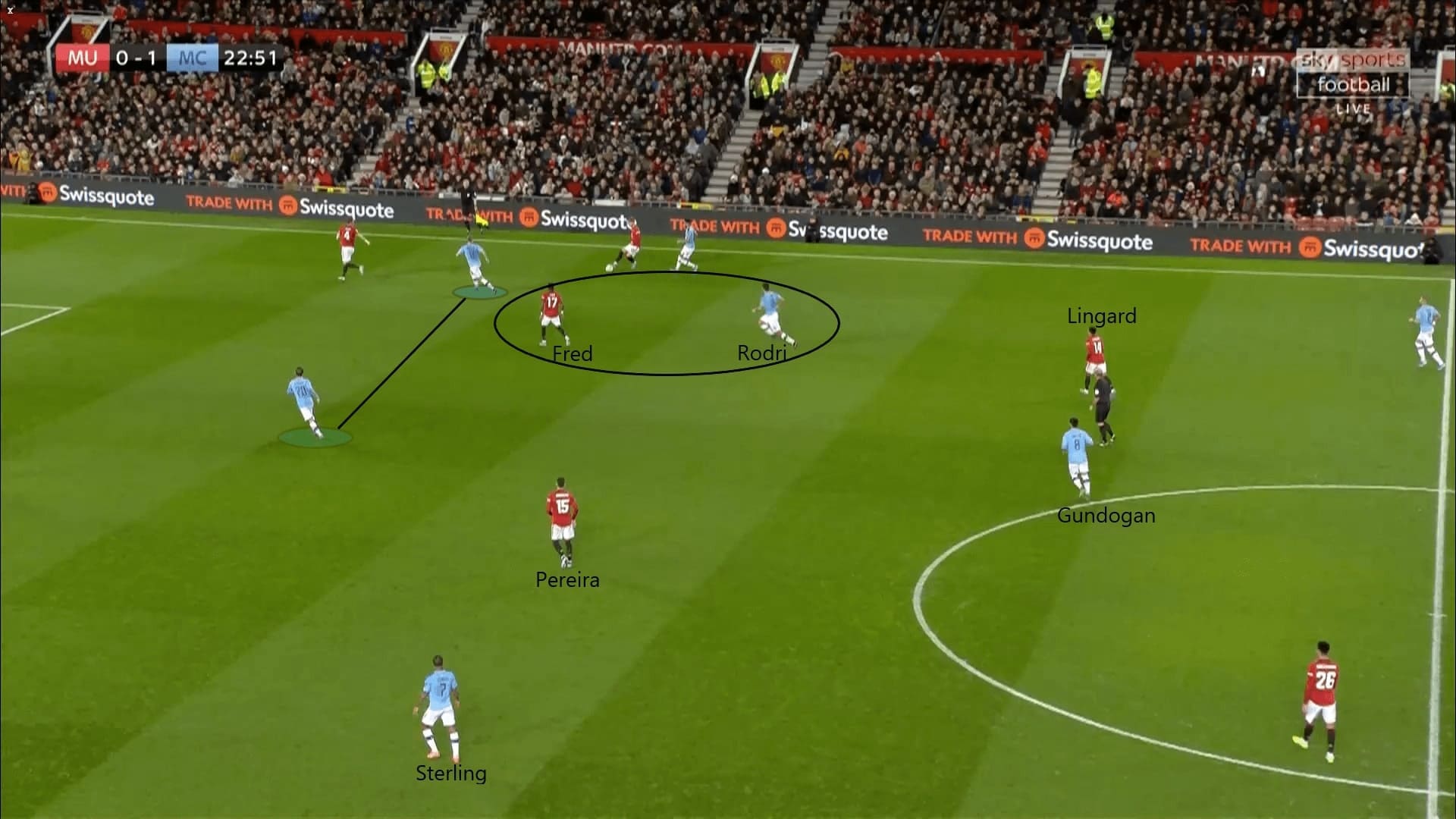
Direct football of United
The xG of United was 0.41 in this game, but almost half, 0.19 of them were coming from goal, which was a City error. That hinted the inability of United to create chances, as, excluding the goal, their xG was merely 0.22.
On the contrary to the attack of City, United’s attack was very simple, they played direct football (as their build-up was disrupted by City), tried to exploit the spaces behind defenders. As City committed the full-backs to press, Mendy left his position to mark Greenwood. City’s defensive line was exposed, the horizontal gap between players was huge.
United players shared the same goal: making forward run. Lingard, James and Rashford all sprinted. Of course, with the pace of these players, it was quite likely they could get ahead of City defenders. However, there were problems. First, their runs lacked creativity or cooperation between players, all of them wished to receive the ball to be the goal-scoring hero. They seemed neglected the importance of unselfish runs. Second, it was the limited quality of individuals, they tended to make suboptimal decisions.
For example, this case was a good chance for United to break. James was against Fernandinho at the centre of the pitch, but Fred passed long to Rashford instead of playing a vertical pass to the Welsh. This was a weird decision unless the pass was a pinpoint one that could reach the English’s feet.
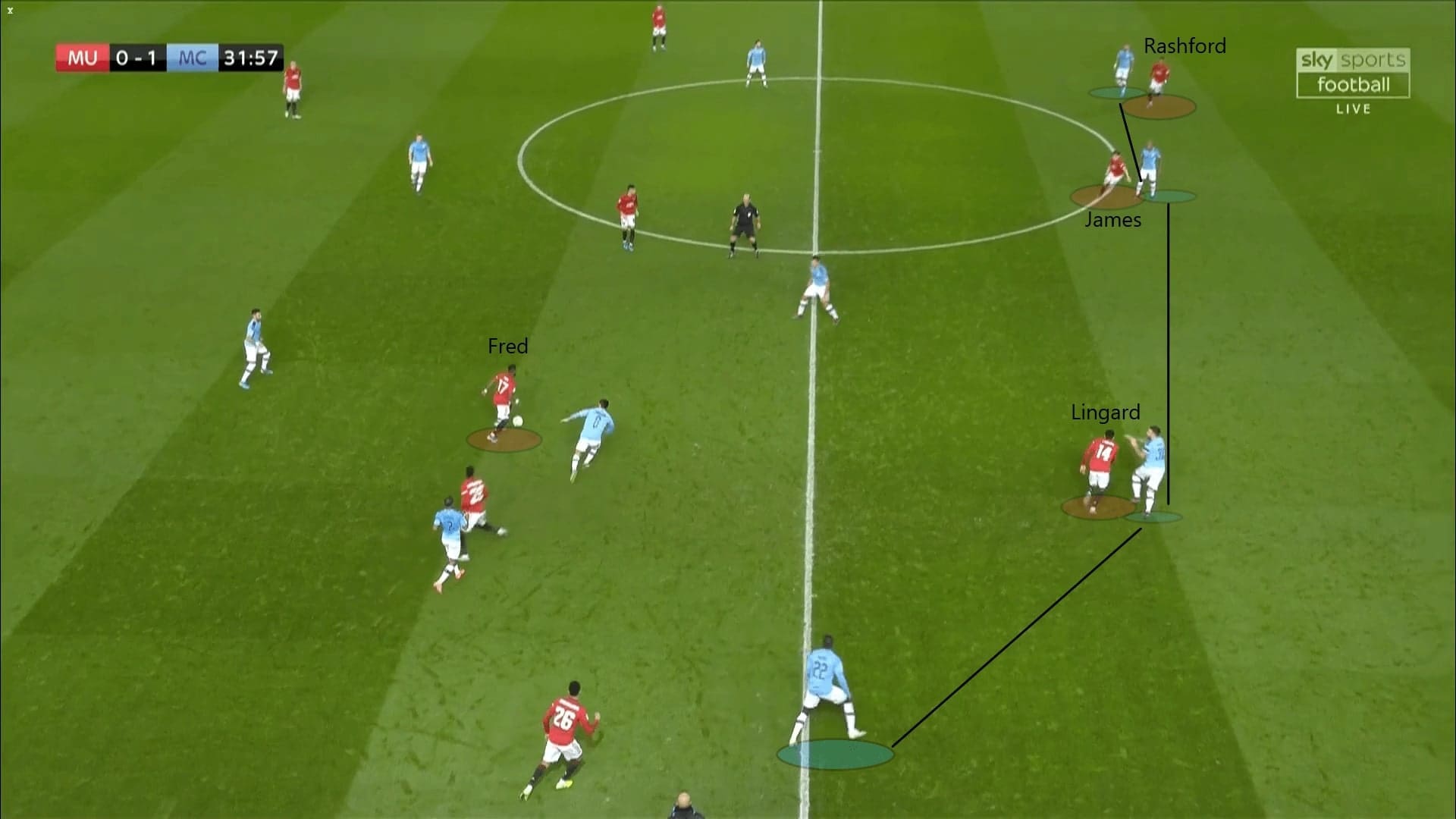
United changed the system, but it was not enough
After the break, Nemanja Matic replaced Lingard. United shifted to a 4-3-1-2 formation, with Rashford and James positioned himself in front of Greenwood. Their pressing intensity reached the peak when they returned to the pitch, as showed by the PPDA, the figure in the second half was 19.5, in the first half, it was 36.0.
In the following example, we showed the press of United and how City dealt with it. In the second half, it was Greenwood to mark Rodri. Fred followed Silva earlier which prevented the dropping player from receiving the ball. James marked Otamendi.
In this scene, despite Rashford pressed Walker and leaving Fernandinho free, the Brazilian did not have a short option because of the man-marking approach of United. If the Brazilian went long, the pass was predictable as United players got time to mark their targets.
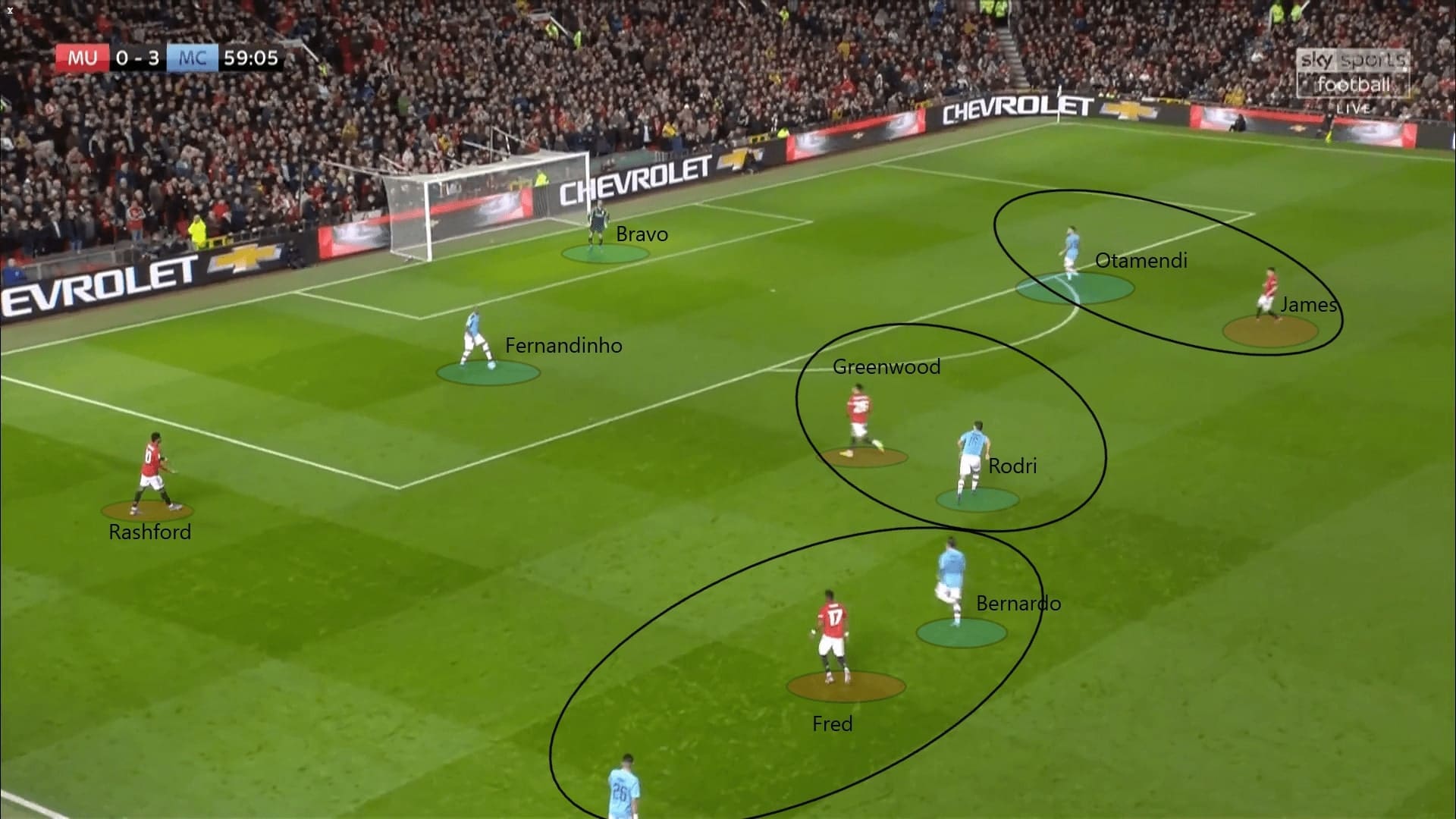
Fernandinho did not panic. City players adjusted their position to continue the build-up play. Otamendi dropped deeper to a position which James was reluctant to follow. Since Greenwood closed off Fernandinho (he was too late), the Brazilian passed the ball to Bravo. At the same time, Rodri was freed from the marking of Greenwood. Despite Matic anticipated the pass, he was too far away from covering the Spaniard.
With the utilization of goalkeeper, Bravo, as an entrepot, City created spaces again/ Rodri received the ball with rooms. Another point showing the difference between Rodri and Fred was his awareness. He checked his shoulders before receiving the ball, then quickly adjusted his body orientation for a pass to Otamendi.
City could play out from the back despite United adjusted their shape to press.
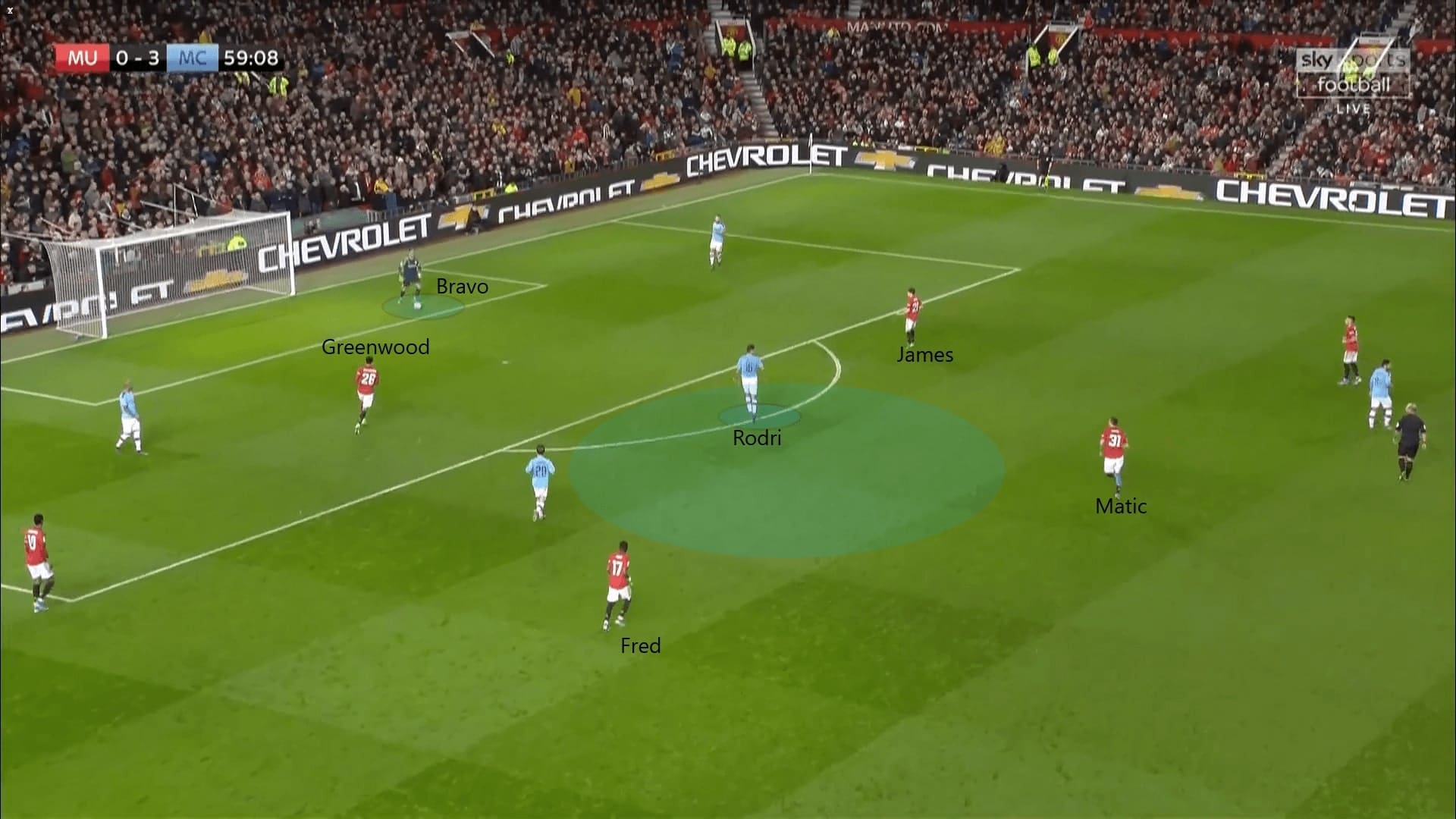
In the attacking phases, United were more comfortable when playing out from the back as City players were slightly tired. The home players faced less pressure. Also, their centre-backs tried more vertical passes to penetrate at the centre. The shift of formation gave United more man in the central zone, hence, Greenwood was always freed to receive the ball between the lines.
As demonstrated in this image, two City players, Rodri and Gündoğan positioned themselves higher to set the pressing trap on Matic. However, the Serbian was not always considered as an option to pass. Lindelöf found Greenwood, he utilized the space between lines and progressed the ball.
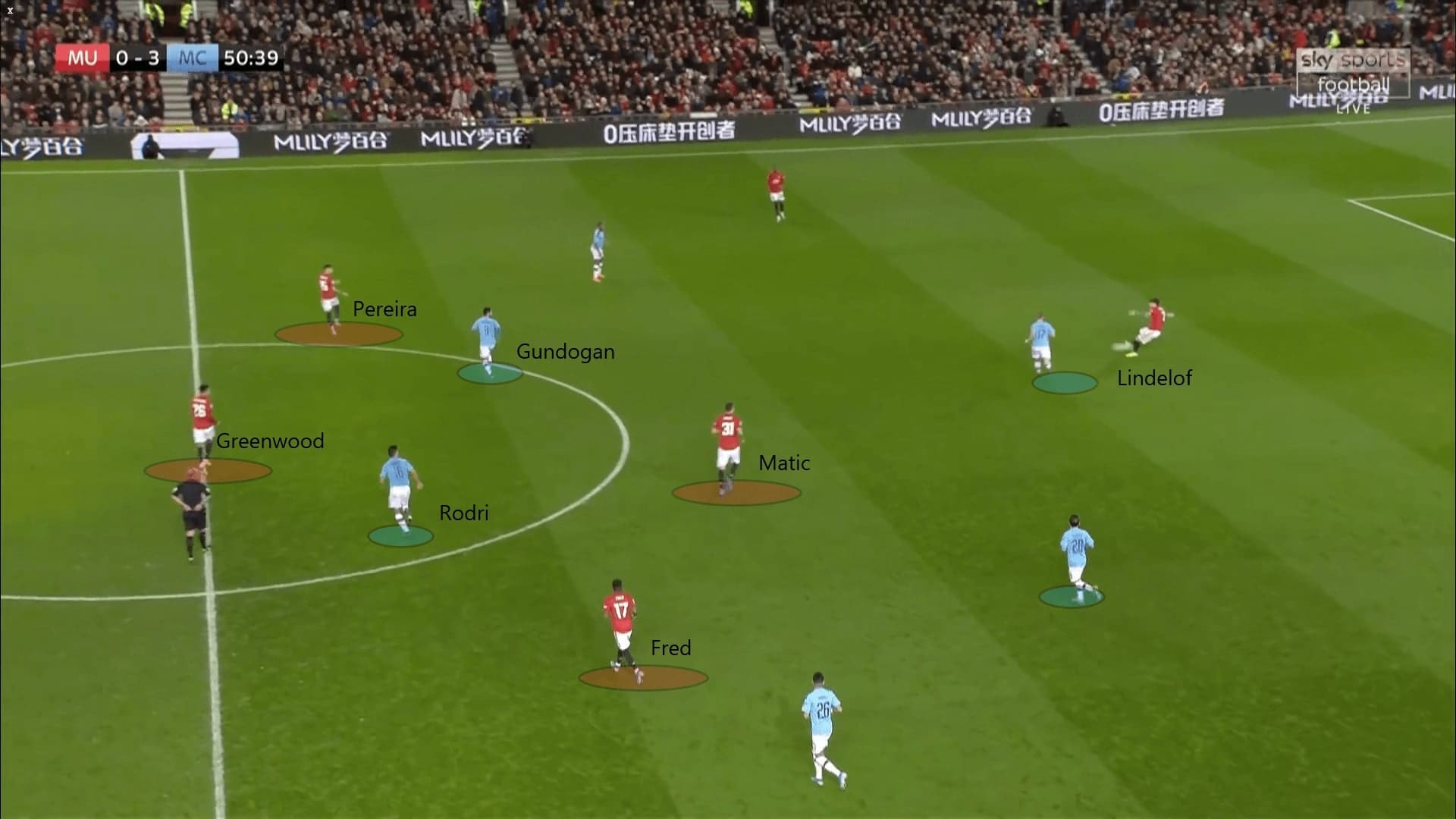
When United reached the final third, their quality of individuals and creativity were not enough, we tried to demonstrate some of them in this example. On this occasion, James decided to cut inside into a bunch of players. However, he found that a pass was difficult due to the poor positioning and movements of his teammates.
Greenwood and Rashford were in a two v two situation against two centre-backs, they stretched Otamendi and Fernandinho. Therefore, the gap between the two City centre-backs increased. None of them were going to exploit that gap and receive a lofted ball from James. If they did it, they could have a shooting chance against Bravo.
On the far side, Walker was paying attention to James. Williams should have moved into an advanced position to provide the width on the left. The 19-year-old were too conservative, he did not join the attack. Before James passed the ball to Williams, Mahrez anticipated it and intercepted.
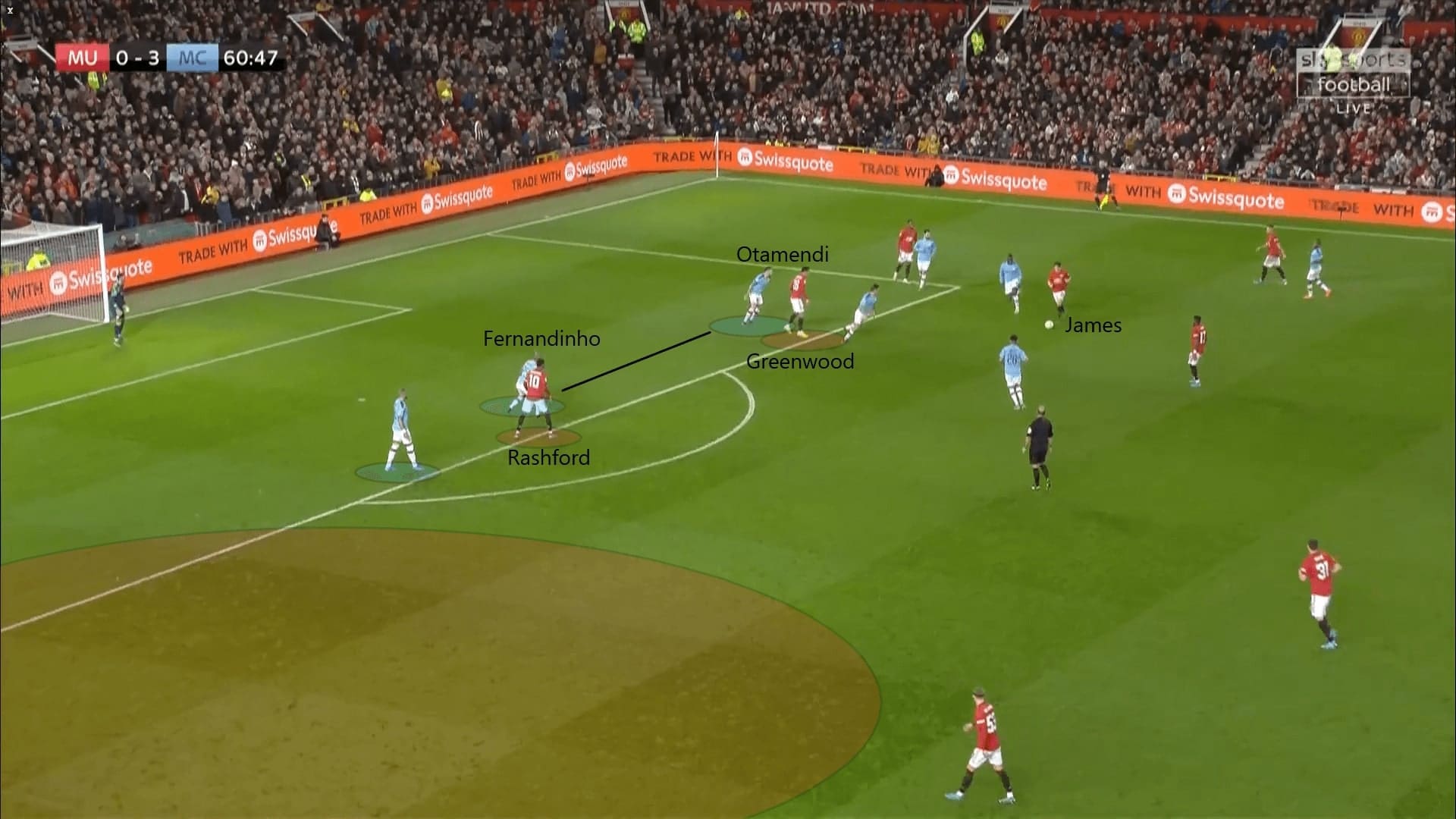
Conclusions
For United, it was a disappointment that they lost the derby. They could not replicate the game in December as the contexts and choice of players were different. A larger problem was their inefficacy of the attacks and defence, Their attack lacked creative movements to generate spaces, or causing confusion of opponents. Their man-marked approach failed to prevent the build-up of City. In the next leg, United were forced to attack, if they did not defend well, same issues could happen again.
This game was a good test for City, it proved City needed the energetic high press very much. They should have converted more chances than only three. They were yet to qualified to the final because they still have to play against United at the Etihad.




Comments